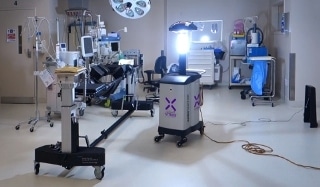Mar 10 2016
Last Thursday, the Centers for Disease Control & Prevention (CDC) issued a report on superbugs and the risk they pose to hospital patients stating that “more work is needed – especially in fighting antibiotic-resistant bacteria.” Hospital acquired infections (HAIs) kill nearly 200 people in the U.S. every day and affect 1 in 25 hospital patients – and these numbers do not include infections acquired at skilled nursing, long-term acute care and outpatient surgery facilities.
 Xenex's new LightStrike Germ-Zapping Robots use Full-Spectrum pulsed xenon light technology to destroy deadly superbugs and antibiotic-resistant bacteria before they harm patients. (Photo: Business Wire)
Xenex's new LightStrike Germ-Zapping Robots use Full-Spectrum pulsed xenon light technology to destroy deadly superbugs and antibiotic-resistant bacteria before they harm patients. (Photo: Business Wire)
Xenex Disinfection Services today announced the launch of its new LightStrike™ Germ-Zapping Robots™, a portable disinfection system that destroys antibiotic-resistant bacteria in a four-minute cycle. More than 300 hospitals, long-term acute care, outpatient surgery and skilled nursing facilities use Xenex’s Full-Spectrum™ high intensity pulsed xenon light technology to destroy deadly superbugs before they harm patients. Numerous hospitals have reported significant decreases in their infection rates after using Xenex’s Germ-Zapping Robots for room disinfection, and published their infection reduction results in peer-reviewed journals. LightStrike uses pulsed xenon to create broad spectrum, highly intense light covering the entire germicidal spectrum and is the only ultraviolet disinfection technology shown, in multiple peer-reviewed published studies, to help hospitals reduce infection rates.
“Hospitals using Xenex Germ-Zapping Robots have reported and published 50, 70 and 100 percent decreases in their infection rates. More can and should be done to stop the spread of the superbugs that harm patients and hospital employees. Don’t go to a hospital unless your room has been properly disinfected because superbugs can dwell on surfaces for five months just waiting to infect the next patient,” said Morris Miller, CEO of Xenex. “Our xenon light robots destroy germs and bacteria in less than five minutes. Hospitals using our technology have reported and published data on fewer infections and a return on their investment in a matter of months – that’s good news for the patients and the hospital’s bottom line.”
The new CDC report points to six antibiotic-resistant threats, which include:
- Carbapenem-resistant Enterobacteriaceae (CRE);
- Methicillin-resistant Staphylococcus aureus (MRSA);
- ESBL-producing Enterobacteriaceae (extended-spectrum β-lactamases);
- Vancomycin-resistant Enterococcus (VRE);
- Multidrug-resistant Pseudomonas aeruginosa; and
- Multidrug-resistant Acinetobacter.
LightStrike robots destroy all of these superbugs, as well as Clostridicum difficile (C.diff) spores, in a four-minute disinfection cycle.
In addition to its 20 percent faster cycle time, LightStrike includes patented SureStrike™ technology, which validates bulb ignition and guarantees a proper broad spectrum pulse for every disinfection cycle. Xenex robots also include HAI rate tracking, which correlates use of the robot and the hospital’s own real-time HAI data to track the disinfection program’s effectiveness.
Xenex officials believe that LightStrike’s shortened cycle time provides tremendous value to hospitals, especially in the Operating Room environment. “Surgical site infections devastate patients and cause unneeded expense for hospitals. Hospitals using Xenex Germ-Zapping Robots have published studies showing 100 percent and 46 percent decreases in their SSI rates after using Xenex to disinfect their ORs at the end of the day. Our LightStrike robot is so efficient that they can run it in 2-minute cycles in between cases in the OR to further bring down contamination,” said Dr. Mark Stibich, Chief Scientific Officer of Xenex.
Designed for speed, effectiveness and ease of use, hospital cleaning staff operate the LightStrike robot without disrupting hospital operations. Without contact or chemicals, the robot eliminates harmful microorganisms safely and effectively. According to Xenex customers, LightStrike can disinfect 30-62 hospital rooms per day, including: patient rooms, operating rooms, equipment rooms, emergency rooms, intensive care units and public areas.
Proven to Reduce HAI Rates
MD Anderson Cancer Center, the Central Texas Veterans Health Care System, Cooley Dickinson Health Care, Trinity Medical Center, Orlando Health South Seminole Hospital and other hospitals have published 14 studies providing evidence of the robot’s efficacy in highly regarded scientific journals that include the American Journal of Infection Control (AJIC), Journal of Infection Prevention, Infection Control & Hospital Epidemiology (ICHE) and BMC Infectious Diseases.